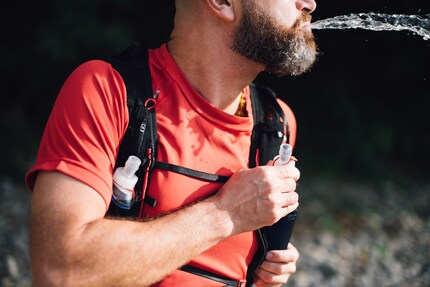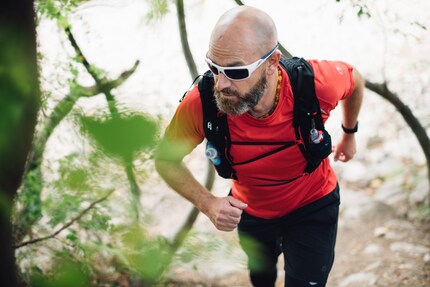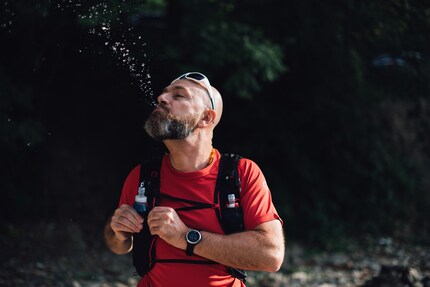
Guide
Had enough of energy gels? Here are five alternatives
by Siri Schubert

You're doing great, you're going to set a new personal best. In your euphoria, however, you haven't fuelled yourself enough. The hammerman comes in the form of a hunger pang. Here are some nutrition tips to help you break your record.
No two bodies are the same. The type and amount of food consumed during sport has different effects on each individual. Some people can tolerate practically anything, while others react extremely sensitively to unusual behaviour or new products.
I find it difficult to eat solid food on long runs and then keep it down. One or two hunger pangs were the result. It's stupid when that happens during a race. I now know that this is due to the high intensity and that my stomach has no capacity to absorb anything solid. The solution for me is therefore sports gels.

If you want to focus on nutrition during endurance sports competitions, you need to take the last few days before the competition into account. The rules are simple:
If a strenuous performance is in the foreground and the exercise lasts longer than 45 to 60 minutes, your carbohydrate stores should be well filled on day X. You can do this with a carbohydrate-rich diet in the last two to three days before the competition, although you can also provide carbohydrates with drinks such as fruit juices or sweets.
The last two meals should be easy to digest (no more fibre, salad or vegetables). Eat your last meal at least two and a half to three hours before the start so that your stomach is not preloaded during the race.
Digestibility is crucial
During the competition itself, it is important to minimise stress on the stomach, as the microclimate of the stomach is often disrupted by sporting exertion. The less it has to work, the better the body can maintain its athletic performance. That's why digestibility is at the forefront of competition catering.
Liquids are easier to digest than solid food
The following applies to liquid and semi-liquid food: intensive loads slow down digestion, while increasing volume speeds up digestion. The latter does not mean that you should drink litres. But it does mean that a few decilitres of liquid are digested faster than almost no liquid.
The longer, the more difficult
If you're running long distances, you should start your energy intake early so that you don't run into a deficit. The longer the race lasts, the more sensitive your stomach becomes and the more important it is to know what you can and cannot tolerate. This applies both to the composition of the food and the intensity of the exertion.
Under 30 minutes
Up to a duration of 30 minutes, there is nothing to consider apart from a sensible diet beforehand. You can also manage 30 minutes at high intensity without food or fluids without any loss of performance.
30 to 60 minutes
If you are exercising for up to an hour, it makes sense to drink something from time to time. Do you have a dry mouth? Take a sip. It can be just water, you don't need carbohydrates to maintain your athletic performance for an hour
60 to 120 minutes
After one hour of exercise, you should regularly consume carbohydrates as well as fluids. Around 30 grams per hour is recommended, which corresponds to a gel tube of around 50 grams, for example. 30 gram gels should therefore be consumed approximately every 40 minutes. Important: always rinse with water.
Two to three hours
Carbohydrate intake becomes increasingly important as the duration of the race increases; around 50 to 60 grams per hour is recommended. You should also add salt if you are exercising for several hours, especially in high temperatures.
From three hours
The carbohydrates stored in the muscle have been completely used up, which is why further carbohydrate intake is crucial. Around 60 to 80 grams per hour are now required
.
From four hours
Fat, protein and dietary fibre are not required for competitions lasting up to around four hours and at high intensities. They slow down digestion if they are consumed in significant quantities. However, as the intensity automatically decreases somewhat over several hours of exercise, a fat intake can also be useful as the duration of the race increases. However, a high carbohydrate intake remains at the centre of attention.
As a general rule
The quantities should be tested individually. Some athletes can consume up to 100 grams of carbohydrates per hour, others much less. The longer the race, the more important it becomes to maximise your energy intake. In most cases, more energy can be absorbed on the bike than when running.

The more intense the exertion, the less strain should be placed on the stomach. Digestive problems during a competition are therefore often not due to ingesting something intolerable. Rather, it is because the intensity is too high and the stomach has no capacity to absorb anything.
At high intensities, sports drinks and sports gels are best tolerated. If solid food is desired, then it is best to eat it in small to very small portions. The more ingredients are added to a product (caffeine, vitamins, etc.), the greater the risk that you will not be able to tolerate them. You should therefore test everything out in advance. For moderate exertion such as a bike tour or a hike, solid foods such as bars, sandwiches, biscuits, etc. in combination with water may also be appropriate. And without causing digestive problems.
Running
In running, food intake is severely restricted due to the constant shocks and stress on all systems. The guideline for drinking in moderate temperatures is 0.4 to 0.8 litres per hour. The warmer it is, the higher the individual fluid requirement.
Cycling
Absorption capacity is better on the bike than when running, so you can consume a good 1 litre of fluid per hour.
Cross-country running
In winter, lukewarm drinks are best absorbed. Despite the cold, the body needs enough fluids and energy in winter, even if your feelings might tell you otherwise.
Triathlon
Triathlon nutrition should be "tactical". It is best to energise in the transition zone and on the bike split shortly before the transition zone so that you can start the run split with enough energy.
Swimming
It is more difficult to absorb energy when swimming. Therefore, during a triathlon, it is essential to replenish your energy levels immediately after the swim split and arrive at the start with well-filled energy stores, including sufficient fluids.

Have a quick rest here and click on "Follow author". Thank you
From radio journalist to product tester and storyteller, jogger to gravel bike novice and fitness enthusiast with barbells and dumbbells. I'm excited to see where the journey'll take me next.
Practical solutions for everyday problems with technology, household hacks and much more.
Show all